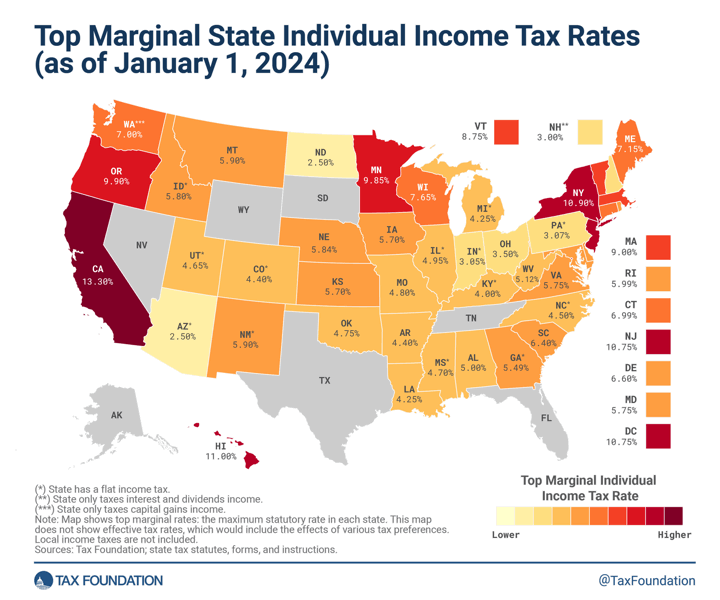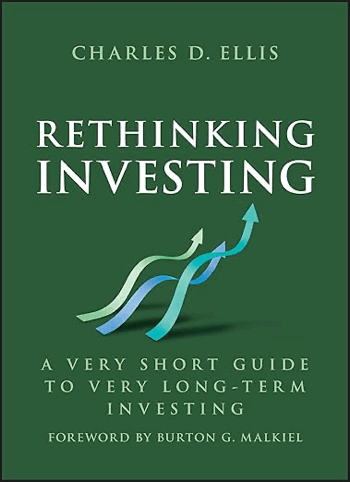Asset Allocation Step 3: How Small-Cap and Value Stocks Enhance Diversification
In earlier steps, we explored how to balance your stock-to-bond ratio and domestic-to-international allocation. Now, it’s time to go deeper. Instead of viewing the total stock market as a single block, investors can divide it into distinct styles or asset classes, such as small-cap and value stocks.
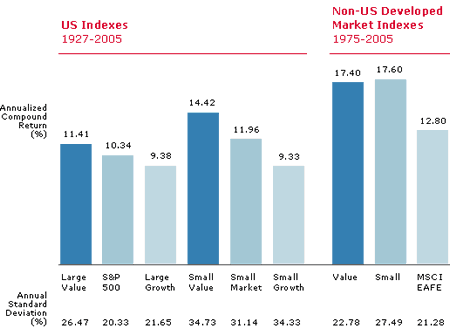
In earlier steps, we explored how to balance your stock-to-bond ratio and domestic-to-international allocation. Now, it’s time to go deeper. Instead of viewing the total stock market as a single block, investors can divide it into distinct styles or asset classes, such as small-cap and value stocks.
These categories behave differently under various market conditions, providing a valuable diversification benefit within your portfolio. As illustrated in the Morningstar style box, blending small and value stocks with broader market funds can reduce volatility and improve long-term performance.
Value vs. Growth Stocks
Value stocks are those that tend to trade at a lower price relative to objective measures like dividend yield, earnings, sales, or book value. For example, you could screen by low P/E ratio. To generalize, value stocks tend to have low growth prospects or are in unglamorous industries. On the other side are growth stocks, which have high relative valuations. Again to generalize, these companies tend to have big growth expectations like Google or Apple.
If you look across long periods of history, it actually turns out that value stocks outperform growth stocks as a whole. People use different ways to explain this phenomenon. One camp says that value stocks are riskier because they are more likely to fail due to poor prospects, so obviously they should have higher return. Others use a behavioral view, saying that since they are “boring” or “ugly” stocks then they tend to be undervalued by investors in general.
Either way, including value stocks as part of a portfolio has also historically provided a diversification benefit, as can be shown by this graph from the excellent book All About Asset Allocation:
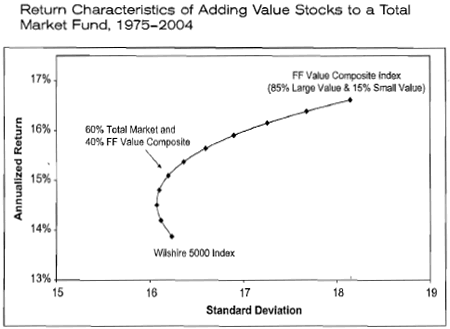
Here we are looking at the reward/risk relationship between essentially a Total Market index (Wilshire 5000) and a Value index for 1975-2004. As you can see, if you add a bit o’ value, you can actually historically obtain higher returns with less risk (standard deviation). At 60% Total/40% Value, you are getting more than 1% extra return at the same risk level as 100% Total Market.
Small vs. Large Stocks
The other way to segment the market is by market capitalization, or the total market value of the companies. Small-cap companies are usually defined as being valued at $300 million to $2 billion, whereas Large-cap companies are at $10 billion and up. Smaller companies historically have been more volatile and have produced higher average returns. Again, some people think small companies are risky due to their higher possibility of failing, while others think they “fly under the radar” which leads to undervaluation.
Combining small and value together, you get the bottom-left corner of the Morningstar box. Lots of people love this Small-Cap Value asset class, and here we see why:
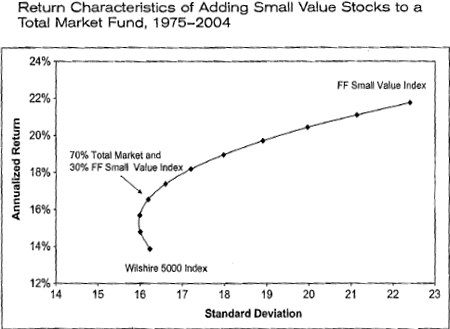
Again, we see the diversification effect of adding Small Value stocks to a Total Market portfolio. At 70% Total and 30% Small Value, the graph shows a 2.7% increase in annualized returns with no increase in volatility. Let’s just say that 2.7% a year is a ton of extra return…
Fama and French, 3-Factor Model
Two pioneers in this area of portfolio theory are Eugene Fama and Ken French. They refer to market-cap and size as two of three “risk factors” that explain 95% of fund performance. The other one is market risk, which is basically our stock/bond ratio. Their research was used to start the investment firm Dimensional Fund Advisors which sells mutual funds which are only available through financial advisors.
The chart below taken from the DFA website illustrates how Large Value historically outperforms Large (Blend) and Large Growth, how Small Value is better than Small (Blend) or Small Growth, how Small outperforms Large, and how this behaviors extends to international markets as well:

More Thoughts and Opinions
Now, please don’t take these exact numbers to be gospel. They are based on averages across the last 30 years or so, and there have been significant periods where growth outperforms value, and large-cap companies outperform small-cap ones. As I mentioned, people are still debating the fundamental source of such diversification benefits. In my amateur opinion, this stuff is less “rock solid” than focusing on stocks vs. bonds or even domestic vs. international.
But, I do think that adding a small amount of exposure (some call this “tilting”) to small-cap and value stocks is definitely worth considering, even if not to the degree of 30% or 40%. If the diversification bonus persists, you are getting more return and less risk. If not, it may turn out you just take on a little more risk, and earn a little more return. But since it’s only a small part of your total portfolio, that’s not the end of the world. I can’t see it making my portfolio implode or anything, so I feel like the potential upside is worth it to me.
However, if you don’t believe strongly in this benefit, you shouldn’t tilt because there will be long periods where growth goes nuts, and you’ll be tempted to change your allocation. Just doing it because it seems like a nice idea and changing your mind is worse than never doing it at all. Even now, many magazines are saying “Value is over, time for Growth!” If in doubt, I recommend doing more reading about this area and either believe or dismiss it. Nothing wrong with sticking with simplicity and broad, total markets.
Now as for the exact breakdown of % Large / % Large Value / % Small Value and all that, I’m not going to decide that just yet. Next I want to list side-by-side some model portfolios from authors and experts in the area for some alternative views.
Whew! Long post.
Share
What was your reaction?
 Like
0
Like
0
 Dislike
0
Dislike
0
 Love
0
Love
0
 Funny
0
Funny
0
 Angry
0
Angry
0
 Sad
0
Sad
0
 Wow
0
Wow
0
